The car power seat switches market is set to experience consistent growth from 2025 to 2035, with a projected compound annual growth rate (CAGR) of 5%. The market is anticipated to expand from USD 646 million in 2025 to USD 1,052.2 million by 2035. This steady growth reflects the rising demand for enhanced automotive interior comfort, as more consumers seek personalized, adjustable seating in modern vehicles. The automotive sector continues to prioritize luxury and comfort, with power seat switches becoming a standard feature in both mid-range and high-end vehicles.
Furthermore, the trend toward electric vehicles (EVs) is also expected to contribute to market growth, as EVs often offer advanced features to enhance the driving experience. Over the next decade, the car power seat switches market is likely to benefit from increasing consumer preferences for comfort-driven features and automation in vehicles. As automotive manufacturers integrate more electronic systems into their designs, demand for power seat switches will grow across different vehicle segments.
With the continual push for driver and passenger convenience, the market is positioned for sustained expansion. This shift is particularly evident in the growing adoption of power-adjustable seats that enable fine-tuned positioning, offering enhanced comfort and reducing driver fatigue. Power seat switches are expected to remain an integral part of modern vehicle interiors.
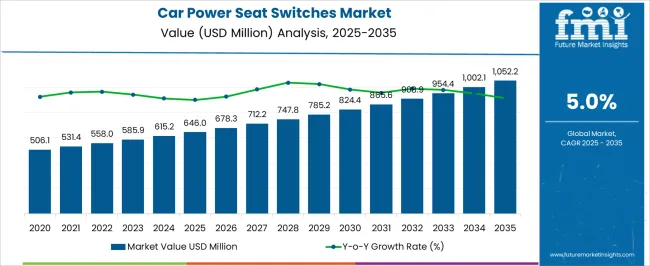
| Metric | Value |
|---|---|
| Car Power Seat Switches Market Estimated Value in (2025 E) | USD 646.0 million |
| Car Power Seat Switches Market Forecast Value in (2035 F) | USD 1052.2 million |
| Forecast CAGR (2025 to 2035) | 5.0% |
The car power seat switches market is estimated to hold a notable proportion within its parent markets, representing approximately 8-10% of the automotive switches market, around 6-7% of the automotive interior components market, close to 12-14% of the automotive electrical systems market, about 5-6% of the vehicle comfort systems market, and roughly 3-4% of the automotive electronics market. Collectively, the cumulative share across these parent segments is observed in the range of 34-41%, reflecting the growing importance of power seat control mechanisms within the broader automotive component landscape.
The market has been influenced by the increasing demand for comfort, convenience, and customization in modern vehicles, where ease of adjustment, durability, and integration with electrical systems are prioritized. Adoption is guided by procurement decisions that emphasize high-quality switch performance, longevity, and compatibility with various seat systems.
Market participants have focused on developing switches that offer enhanced ergonomics, reliability, and aesthetic appeal, contributing to overall driving comfort. As a result, the car power seat switches market has not only captured a significant share within automotive switches and electrical systems. It has also influenced interior components, vehicle comfort systems, and automotive electronics markets, highlighting its strategic role in enhancing vehicle personalization, user experience, and operational efficiency.
The car power seat switches market is experiencing consistent growth, primarily driven by increasing consumer demand for comfort, customization, and convenience in automotive interiors. Rising adoption of premium and mid-range vehicles equipped with electronically controlled seating systems is accelerating the integration of advanced seat switch technologies. The growing emphasis on vehicle ergonomics, passenger comfort, and user-centric design has led to widespread installation of power seat switches across multiple vehicle categories.
Automakers are focusing on enhancing the driving experience by offering seat positioning systems with memory, lumbar control, and multi-directional adjustments, which are directly influencing market expansion. Rapid electrification of vehicle components, the trend toward smart and connected vehicles, and advancements in automotive electronics are supporting the evolution of power seat switch designs and functionalities.
The market is also being positively influenced by regulatory safety standards and consumer preference for personalized in-cabin experiences. As automotive OEMs continue to differentiate through interior technology, the demand for high-performance, durable, and intuitive seat switches is expected to grow across both passenger and commercial vehicle segments globally.
The car power seat switches market is segmented by switch type, technology, design, operation, seat type, sales channel, and geographic regions. By switch type, car power seat switches market is divided into Multi-function switches, Single-function switches, and Memory switches. In terms of technology, car power seat switches market is classified into Electronic switches and Smart switches. Based on design, the car power seat switches market is segmented into button-based, Joystick, and Touch-sensitive.
By operation, car power seat switches market is segmented into Single operation, Forward/Backward movement, Up/Down movement, Tilt adjustment, Lumbar support adjustment, Headrest adjustment, and Multiple operation. By seat type, car power seat switches market is segmented into Driver seat, Front passenger seat, and Rear seat.
By sales channel, car power seat switches market is segmented into OEM and Aftermarket. Regionally, the car power seat switches industry is classified into North America, Latin America, Western Europe, Eastern Europe, Balkan & Baltic Countries, Russia & Belarus, Central Asia, East Asia, South Asia & Pacific, and the Middle East & Africa.
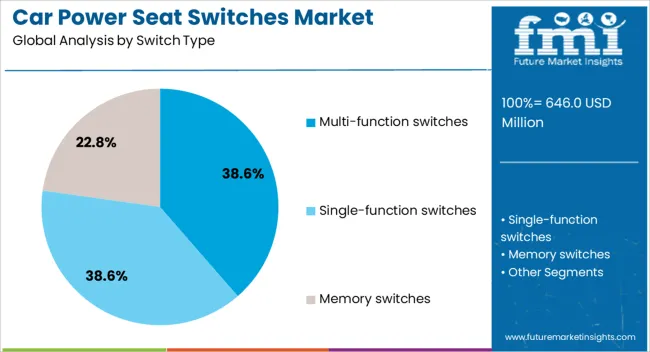
The multi-function switches segment is projected to hold 38.6% of the car power seat switches market revenue share in 2025, establishing itself as the leading switch type. This segment is gaining traction due to its ability to consolidate multiple seat control functions, such as recline, height adjustment, seat tilt, and lumbar support, into a single interface. The integration of these functionalities into one switch not only enhances user convenience but also streamlines the overall interior design by reducing switch clutter.
As consumers increasingly seek seamless and intuitive vehicle interiors, multi-function switches are being favored for their ergonomic efficiency and ease of use. Automakers are incorporating these switches into both luxury and mid-tier vehicle models to improve functionality without increasing dashboard complexity.
The segment is further supported by innovations in control logic and interface design that allow for smoother, more responsive adjustments. Their ability to support complex seat configurations while maintaining compact form factors is reinforcing their widespread application in modern automotive seating systems.
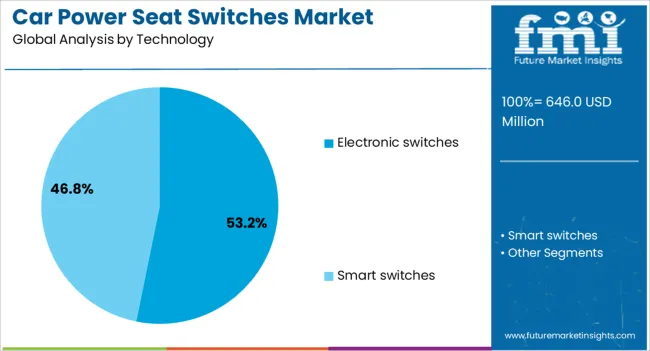
The electronic switches segment is anticipated to account for 53.2% of the car power seat switches market revenue share in 2025, positioning it as the dominant technology type. This leadership is being driven by the shift toward digital and programmable vehicle components, which offer enhanced precision, longer life cycles, and increased integration with vehicle electronics. Electronic switches enable more sophisticated seat control features such as memory presets, auto-adjustment based on driver profile, and seamless integration with infotainment systems.
Unlike mechanical alternatives, electronic systems offer improved reliability, reduced wear and tear, and the capability for real-time diagnostics. The segment is also benefiting from the growing demand for smart interiors in electric and premium vehicles, where electronic controls are essential for intelligent seat adjustment and personalization.
Furthermore, these switches support safer driving environments by minimizing driver distraction through intuitive feedback mechanisms. As automakers continue to digitize vehicle cabins and reduce mechanical complexity, the adoption of electronic switches in power seating applications is expected to increase steadily across global markets.

The button based design segment is projected to capture 35.2% of the car power seat switches market revenue share in 2025, making it the leading design preference. Its dominance is being driven by the familiarity and user-friendly nature of button interfaces, which provide clear tactile feedback and easy identification. Button based switches are being widely adopted due to their ability to deliver precise and reliable control for seat adjustments without requiring advanced user training or adaptation.
The segment is particularly favored in mainstream vehicle models, where simplicity and durability are prioritized alongside cost-effectiveness. Moreover, the growing trend toward modular interior components is encouraging manufacturers to standardize button designs that can be easily adapted across different vehicle platforms.
Developments in button materials, illumination, and response sensitivity are also improving their aesthetic integration and functionality As automakers focus on enhancing the tactile quality of in-cabin interfaces while maintaining intuitive usability, button based seat switch designs are expected to retain their strong presence in both entry-level and advanced automotive seating systems.
The car power seat switches market is experiencing robust growth due to heightened consumer demand for personalized comfort and adjustability in car interiors. Electric vehicle adoption has created new opportunities for integration, while trends in seat customization are pushing manufacturers to innovate further. However, challenges such as cost and complexity in the integration process could limit widespread adoption. Moving forward, the market's success will depend on balancing technological advancements with consumer price sensitivity.
The car power seat switches market has seen increasing demand driven by consumer preferences for personalized, comfortable automotive interiors. As cars become more advanced, comfort features such as power-adjustable seats are in high demand. Power seat switches allow users to fine-tune their seating positions for optimal comfort and support. This has led automakers to incorporate more customizable seat configurations across various vehicle segments, from luxury to economy models, expanding the market reach and driving overall growth.
As electric vehicles (EVs) continue to gain popularity, the demand for power seat switches is expected to grow further. EVs, which prioritize interior comfort and tech integration, often include advanced features such as electronically adjustable seats. This trend opens up significant opportunities for manufacturers to design innovative power seat switches that cater to the growing number of EV consumers. With increasing emphasis on the comfort of EV passengers, the integration of power seat switches is anticipated to rise in electric mobility.
Another notable trend in the car power seat switches market is the push for enhanced seat adjustability and customization. Consumers are demanding more control over their seating positions, such as lumbar support, memory functions, and multi-way adjustments. This has pushed manufacturers to design more advanced power seat switch systems that offer finer control over seat movements. The trend towards smart seating systems is likely to drive the growth of car power seat switches in the coming years, especially in high-end vehicle models.
Despite the increasing demand for advanced car power seat switches, the market faces challenges related to integration complexity and cost. For automotive manufacturers, incorporating high-tech power seat switches can increase vehicle production costs, especially when integrating advanced features like memory settings, heating, and cooling functions. Additionally, the complexity of ensuring compatibility with various car models, electrical systems, and consumer preferences remains a hurdle. As such, manufacturers will need to balance innovation with cost-efficiency to cater to a wide range of consumers.

| Country | CAGR |
|---|---|
| China | 6.8% |
| India | 6.3% |
| Germany | 5.8% |
| France | 5.3% |
| UK | 4.8% |
| USA | 4.3% |
| Brazil | 3.8% |
The global car power seat switches market is projected to grow at a CAGR of 5% from 2025 to 2035. China leads with a growth rate of 6.8%, followed by India at 6.3%, and France at 5.3%. The United Kingdom records a growth rate of 4.8%, while the United States shows the slowest growth at 4.3%. This growth is driven by the increasing demand for comfort and convenience features in automobiles, particularly in premium and electric vehicle (EV) segments. Emerging markets like China and India benefit from rising vehicle production and consumer demand for advanced features, while developed markets focus on luxury and high-tech options. This report includes insights on 40+ countries; the top markets are shown here for reference.
The car power seat switches market in China is expected to grow at a rate of 6.8%, driven by the rapid expansion of the automotive industry. The demand for comfort and convenience features, especially in premium cars, is rising significantly as disposable income grows. The adoption of electric vehicles (EVs) is also contributing to the increased demand for advanced car features like power seat switches, as EVs focus heavily on improving user experience. The government’s push for greener transportation technologies and the growing middle class are accelerating the need for vehicles equipped with comfort-driven innovations, such as power-adjustable seating systems.
The car power seat switches market in India is projected to grow at 6.3%, supported by the expanding automotive manufacturing sector and the increasing demand for comfort in vehicles. The shift towards premium vehicles, including luxury cars, is one of the main drivers, as consumers increasingly prioritize comfort and convenience. As the middle class continues to grow, so does the demand for vehicles equipped with advanced features like power seat switches. Additionally, the rise of electric mobility in India is also contributing to the demand for high-tech car components. Companies are expanding their presence in India, contributing to the market’s growth.
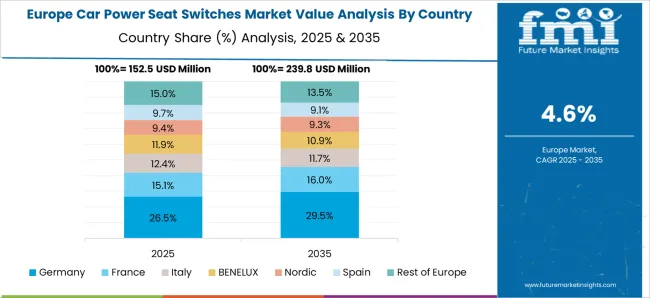
The car power seat switches market in France is expected to grow at a rate of 5.3%, driven by the rising demand for automotive comfort and convenience features. With a strong automotive manufacturing base, France is focusing on the integration of advanced technologies in vehicles, including comfort systems like power seat switches. The automotive industry is evolving with an emphasis on enhancing driver and passenger experiences. The shift towards electric vehicles (EVs) in Europe is further accelerating this trend, as consumers demand more innovative features in their vehicles. The French market is seeing a rise in luxury and premium vehicle sales, further boosting the demand for such switches.
The car power seat switches market in the United Kingdom is projected to grow at 4.8%, with the demand driven by the increasing adoption of luxury cars and electric vehicles. The United Kingdom’s strong automotive industry and consumer preference for advanced technologies contribute to the growth of the market. Consumers are increasingly interested in comfort and convenience features, such as power seat switches, which are being integrated into a variety of vehicles, including electric and hybrid models. Additionally, the UK government’s push for zero-emission vehicles and the growth of electric vehicle production are boosting the demand for advanced vehicle components.

The car power seat switches market in the United States is expected to grow at a rate of 4.3%, with demand driven by the increasing adoption of luxury cars, SUVs, and electric vehicles (EVs). As consumers prioritize convenience and comfort, the demand for adjustable seating systems and power seat switches is on the rise. In addition to the growing electric vehicle market, the trend toward personalized vehicle interiors is contributing to the expansion of this market. The USA automotive industry’s focus on innovation and premium vehicle features further supports the demand for such technologies, with automakers integrating advanced seat control systems into their models.
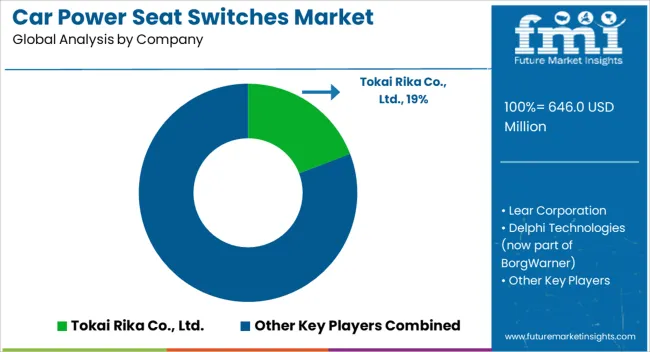
The car power seat switches market is experiencing significant growth as automotive manufacturers continue to focus on enhancing comfort and convenience for passengers. Leading players in the market, such as Tokai Rika Co., Ltd., Lear Corporation, and Delphi Technologies (now part of BorgWarner), are at the forefront of producing advanced power seat switches that offer smooth, precise adjustment capabilities. These switches are integral to premium and luxury vehicles, where personalized seating positions are increasingly becoming a standard feature. Omron Corporation and Panasonic Corporation are contributing by incorporating state-of-the-art technology, such as memory functions and adaptive controls, to enhance user experience and offer higher levels of automation.
Additionally, Alps Alpine Co., Ltd. and Johnson Electric Holdings Limited are introducing solutions designed to provide more ergonomic and user-friendly control interfaces, catering to evolving consumer expectations in the automotive industry. As the automotive industry transitions towards electric vehicles (EVs), the demand for power seat switches is also expanding due to the integration of smart and energy-efficient systems. Automakers are increasingly focusing on reducing the weight and size of components to improve the overall vehicle performance, thereby driving innovation in power seat switch designs. The introduction of features such as seat heating and cooling, memory settings, and integrated heating/cooling controls is further pushing the market’s growth. Companies like Lear Corporation and Alps Alpine are responding to these trends by incorporating advanced materials and digital technology, ensuring the switches are more durable and energy-efficient. As car manufacturers adopt more digital interfaces and advanced electronics, the future of the car power seat switches market looks promising, with significant potential for further innovation and integration into the connected car ecosystem.
| Item | Value |
|---|---|
| Quantitative Units | USD 646.0 Million |
| Switch Type | Multi-function switches, Single-function switches, and Memory switches |
| Technology | Electronic switches and Smart switches |
| Design | Button based, Joystick, and Touch-sensitive |
| Operation | Single operation, Forward/Backward movement, Up/Down movement, Tilt adjustment, Lumbar support adjustment, Headrest adjustment, and Multiple operation |
| Seat Type | Driver seat, Front passenger seat, and Rear seat |
| Sales Channel | OEM and Aftermarket |
| Regions Covered | North America, Europe, Asia-Pacific, Latin America, Middle East & Africa |
| Country Covered | United States, Canada, Germany, France, United Kingdom, China, Japan, India, Brazil, South Africa |
| Key Companies Profiled | Tokai Rika Co., Ltd., Lear Corporation, Delphi Technologies (now part of BorgWarner), Omron Corporation, Panasonic Corporation, Alps Alpine Co., Ltd., and Johnson Electric Holdings Limited |
| Additional Attributes | Dollar sales by switch type (single-axis, multi-axis, modular) and application (luxury vehicles, mid-range vehicles, economy vehicles) are key metrics. Trends include rising demand for adjustable, ergonomic seating solutions, growth in electric vehicle adoption, and increasing focus on user comfort and safety. Regional adoption, technological advancements, and regulatory compliance are driving market growth. |
The global car power seat switches market is estimated to be valued at USD 646.0 million in 2025.
The market size for the car power seat switches market is projected to reach USD 1,052.2 million by 2035.
The car power seat switches market is expected to grow at a 5.0% CAGR between 2025 and 2035.
The key product types in car power seat switches market are multi-function switches, single-function switches and memory switches.
In terms of technology, electronic switches segment to command 53.2% share in the car power seat switches market in 2025.






Our Research Products

The "Full Research Suite" delivers actionable market intel, deep dives on markets or technologies, so clients act faster, cut risk, and unlock growth.

The Leaderboard benchmarks and ranks top vendors, classifying them as Established Leaders, Leading Challengers, or Disruptors & Challengers.

Locates where complements amplify value and substitutes erode it, forecasting net impact by horizon

We deliver granular, decision-grade intel: market sizing, 5-year forecasts, pricing, adoption, usage, revenue, and operational KPIs—plus competitor tracking, regulation, and value chains—across 60 countries broadly.

Spot the shifts before they hit your P&L. We track inflection points, adoption curves, pricing moves, and ecosystem plays to show where demand is heading, why it is changing, and what to do next across high-growth markets and disruptive tech

Real-time reads of user behavior. We track shifting priorities, perceptions of today’s and next-gen services, and provider experience, then pace how fast tech moves from trial to adoption, blending buyer, consumer, and channel inputs with social signals (#WhySwitch, #UX).

Partner with our analyst team to build a custom report designed around your business priorities. From analysing market trends to assessing competitors or crafting bespoke datasets, we tailor insights to your needs.
Supplier Intelligence
Discovery & Profiling
Capacity & Footprint
Performance & Risk
Compliance & Governance
Commercial Readiness
Who Supplies Whom
Scorecards & Shortlists
Playbooks & Docs
Category Intelligence
Definition & Scope
Demand & Use Cases
Cost Drivers
Market Structure
Supply Chain Map
Trade & Policy
Operating Norms
Deliverables
Buyer Intelligence
Account Basics
Spend & Scope
Procurement Model
Vendor Requirements
Terms & Policies
Entry Strategy
Pain Points & Triggers
Outputs
Pricing Analysis
Benchmarks
Trends
Should-Cost
Indexation
Landed Cost
Commercial Terms
Deliverables
Brand Analysis
Positioning & Value Prop
Share & Presence
Customer Evidence
Go-to-Market
Digital & Reputation
Compliance & Trust
KPIs & Gaps
Outputs
Full Research Suite comprises of:
Market outlook & trends analysis
Interviews & case studies
Strategic recommendations
Vendor profiles & capabilities analysis
5-year forecasts
8 regions and 60+ country-level data splits
Market segment data splits
12 months of continuous data updates
DELIVERED AS:
PDF EXCEL ONLINE
Cartridge Heating Element Market Size and Share Forecast Outlook 2025 to 2035
Carboxymethyl Tamarind Kernel Powder Market Size and Share Forecast Outlook 2025 to 2035
Car Tail Light Mould Market Size and Share Forecast Outlook 2025 to 2035
Car OS Market Size and Share Forecast Outlook 2025 to 2035
Caramel Malt Market Size and Share Forecast Outlook 2025 to 2035
Carbon Capture and Sequestration Market Forecast Outlook 2025 to 2035
Cardiac Rehabilitation Market Size and Share Forecast Outlook 2025 to 2035
Carbon Dioxide Incubators Market Size and Share Forecast Outlook 2025 to 2035
Carboxymethyl Tamarind Gum (CMT) Market Size and Share Forecast Outlook 2025 to 2035
Car Cover Market Size and Share Forecast Outlook 2025 to 2035
Cardiology Information System Market Size and Share Forecast Outlook 2025 to 2035
Cardiopulmonary Functional Testing Platform Market Size and Share Forecast Outlook 2025 to 2035
Carbon Enhanced Lead Acid Battery Market Size and Share Forecast Outlook 2025 to 2035
Car Bushing Market Size and Share Forecast Outlook 2025 to 2035
Carbon-negative Cement Market Size and Share Forecast Outlook 2025 to 2035
Card Printer Ribbon Market Size and Share Forecast Outlook 2025 to 2035
Carbon Tetrabromide Market Size and Share Forecast Outlook 2025 to 2035
Carbon Steel Market Size and Share Forecast Outlook 2025 to 2035
Carpet Spot Remover Market Size and Share Forecast Outlook 2025 to 2035
Cardiovascular CT Systems Market Size and Share Forecast Outlook 2025 to 2035

Thank you!
You will receive an email from our Business Development Manager. Please be sure to check your SPAM/JUNK folder too.
Chat With
MaRIA